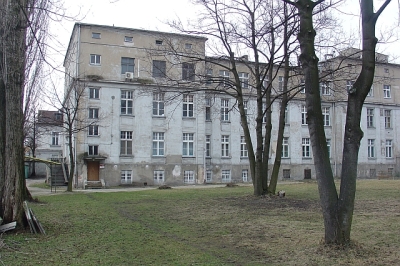This was one of the seven hospitals that operated in the ghetto during the first phase of its existence. Before the war, the Poznanski factory hospital was located here. The building was situated next to the ghetto border, not far from the huge factory complex established by the great Jewish industrialist, but located in the Aryan part of Lodz.
 From the beginning, the hospital on Drewnowska Street had an isolation ward, reserved for patients with contagious diseases. In 1942, during the so-called "shpera", the sick were deported to Chelmno-nad-Nerem. For a few days, one of the assembly points for subsequent groups of people destined for deportation was located here. From there they were transported to the Radogoszcz railway station in Marysin. In 1942, the knitted goods department was housed here. A large laundry was operating in the same building, too.
From the beginning, the hospital on Drewnowska Street had an isolation ward, reserved for patients with contagious diseases. In 1942, during the so-called "shpera", the sick were deported to Chelmno-nad-Nerem. For a few days, one of the assembly points for subsequent groups of people destined for deportation was located here. From there they were transported to the Radogoszcz railway station in Marysin. In 1942, the knitted goods department was housed here. A large laundry was operating in the same building, too.
Three large textile factories employing some 1,200 people - a weaving mill, a knitting mill and a dyehouse - operated in the building at 77 Drewnowska St., which abutted the hospital (what was the Kaszub factory before the war). These factories served both the military and private orders. The factory complex primarily manufactured men's sweaters and earmuffs. The earmuffs reportedly numbered in the millions.
At that time, I was working in the contagius diseases hospital. The hospital was, obviously, located in the ghetto. At Drewnowska Street. [...] It was situated so strangely, that the wire fences marking the ghetto border stretched right next to its front gate, and an armed German military policeman was always standing there. And a military policeman could any time feel like shooting a Jew just to keep in practice.
Arnold Mostowicz, The Yellow Star and the Red Cross, p.17
The labor departments, including the huge laundry at 75 Drewnowska St., which has been almost idle for the last few months, have not been receiving any orders recently and are condemned to vegetation. In the first phase, the department was receiving enormous orders from the army, which were filled with great care and at a low charge, to the complete satisfaction of the customers. It is, thus, hard to understand why the orders were stopped so suddenly and why such an important department is suddenly doomed to liquidation.
The Chronicle of the Lodz Ghetto, November 12, 1942, Vol. 2, p. 366.
The staircase of that workshop welcomes us with a motto from the Eldest of the Jews, written in boldface German and Yiddish: "Our only way is work." Where have we already seen this famous propaganda, this hammering of various slogans into people's heads? Isn't this a small equivalent of [the town of] Zlin, a modest copy of that factory, the only one of its kind in the world? Isn't the spirit of those machine-like people and human-like machines perceptible here? Of course, it is not so clean here, the equipment is not new, and the people employed here do not resemble those of Thomas Bata. The atmosphere is gloomy. A man moves incredibly slowly here; after the shift, his face is animated neither by the working spirit, nor by the enthusiasm in a football stadium. The figures seen in courtyards and staircases had, until now, belonged to an unknown world. But we have known them for a long time, those human shadows of the ghetto.
Oskar Singer, Walking Quickly through the Ghetto, p. 64

 Home
Home
